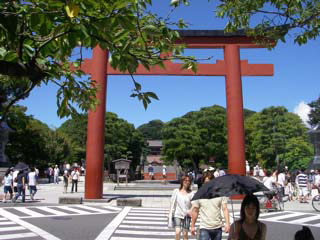Kamakura is a city located in Kanagawa, Japan, about 50 km south- south-west of Tokyo. It's hard to believe that this quiet little town with its many temples was the capital of Japan during the Kamakura shogunate, from 1185 to 1333.
Kamakura's sights are scattered around the city. Most visitors make a beeline for the Great Buddha and stop off at Hase Kannon on the way; these sights can be very crowded on weekends and holidays.
Kamakura has many historically significant Buddhist temples and Shinto shrines. Kotoku-in, with the monumental outdoor bronze statue of Amida Buddha, is the most famous of these. A 15th Century tsunami destroyed the temple that once housed the Great Buddha, but the statue survived and has remained outdoors ever since. Magnificent Zen temples like Kencho-ji and Engaku-ji; the Tokei-ji (a nunnery that was a refuge for women who wanted to divorce their husbands); the Tsurugaoka Hachiman Shrine; the Hase-dera, an ancient Kannon temple; the graves of Minamoto no Yoritomo and Hojo Masako; and the Kamakura- gu where Prince Morinaga was executed, top the list of Kamakura's most famous historical and religious sites.
Kamakura has several hiking trails that can provide relief from the crowds at the more popular shrines and temples. The Daibutsu hiking course starts a few hundred meters down the road from Kotokuin. The trail has several offshoots that lead to various small shrines and temples. If it has rained recently, the trail could be muddy and there are several steep sections.
Kamakura is not just a historical city which has a lot of temples, shrines, and other historical buildings - there are also some popular beaches in Kamakura. You can feel the atmosphere of the Shonan Coast in the bright sunshine and have a good time there, especially in summer.
There are a large number of places to eat in the vicinity of the train station. For a snack, try the local specialty, purple potato soft ice cream (murasaki-imo sofuto), which tastes much better than it sounds (or looks).
(Reference: wikipedia, wikitravel)






